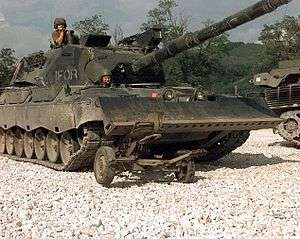Operation Bøllebank
| Operation Bøllebank | |||||||
|---|---|---|---|---|---|---|---|
| Part of the Bosnian War | |||||||
| |||||||
| Belligerents | |||||||
|
|
Jydske Dragonregiment (elements) (as part of UNPROFOR) | ||||||
| Commanders and leaders | |||||||
|
| |||||||
| Strength | |||||||
|
3 T-55 tanks Anti-tank missiles Several artillery pieces |
7 Leopard 1 A5 tanks (1st & 2nd platoon plus squ leader) 3 in reserve (3rd platoon) 1 APC PBV302 | ||||||
| Casualties and losses | |||||||
|
Between 9 (Serb sources) and 150 (Other sources) soldiers killed.[1] Ammunition store destroyed. 3 T-55 tanks withdrew. (disabled according to other sources). | 1 vehicle damaged[1] | ||||||
Operation Bøllebank (English: Operation Hooligan Bashing[1]) was the first combat operation conducted by Danish Armed Forces since World War II. In April 1994, a Danish contingent with elements of the Jydske Dragonregiment on peacekeeping duty in Bosnia, as part of UNPROFORs Nordic battalion (Nordbat 2) located in Tuzla, was ambushed, when trying to relieve a Swedish and Norwegian observation post, Tango 2, that was under heavy artillery fire by the Bosnian Serb Šekovići brigade at the village of Kalesija, but the ambush was dispersed when the UN forces retaliated with heavy fire.
The incident
The ambush started with shelling near Saraci, 8 km southeast from Tuzla, which was ignored. The column, however, came under attack by anti-tank missiles when they reached the village of Kalesija, further east. The UNPROFOR column requested air support, which was rejected. Due to restrictive rules of engagement imposed by the United Nations, Lt. Colonel Lars R. Møller was hesitant, but he decided to return fire. The attack on them ceased after this, but intensified again later, provoking an even stronger response.
The seven German-made Leopard 1A5 tanks fired 72 rounds and destroyed several Serb artillery pieces, an ammunition dump and several bunkers. Serb forces brought three T-55 tanks to the scene, but apparently the Danes did not engage them, as they made no offensive moves. The Leopards, however, fired 19 armour-piercing rounds. The Danes could see in their thermal tank sights that the guns on the T-55s were cold and therefore had not taken part in the engagement according to a non-official report.[2] However, an Italian source claims that, despite the UNPROFOR rules of engagement, the three T-55s were actually hit by the Leopards.[3]
Post-incident

This was the first time a Leopard 1 fired its guns in anger and is one of the largest engagements that took place between UNPROFOR forces and military units involved in the war in Bosnia. It was also the first time since WWII that Danish soldiers were involved in combat operations.
The Danish commander characterized the incident with the words: "the mouse ate the cat" and subsequently named it "Operation Hooligan Bashing".
Another incident took place later that year between Danish peacekeepers and Serb forces near Gradačac in the course of the Operation Amanda.
Notes
- 1 2 3 Hansen, Ole Kjeld (1997). "Operation "Hooligan-bashing" – Danish Tanks at War". Archived from the original on February 21, 2014. Retrieved 29 January 2015.
The Danes themselves suffered no casualties, although Møller got himself a "long-distance-shave " by a fragment, and one of the vehicles was actually hit
- ↑ From Nordbat 2 (unofficial site)
An unofficial statement from a tank commander involved in the battle stated that the Danish tank gunners, using thermal sights only) simply couldn't see the cold T-55 tanks, and the T-55 tank gunners, using older night vision sights, couldn't see the blacked out Danish tanks:
- "In setting their ambush, the Serbs had deployed Soviet-made T-55 tanks in fixed positions; they are accustomed to fighting artillery duels against forces with little ability to fire back. The Danes watched the tanks' infrared searchlights try to find and target their Leopards, but easily stayed out of their sights. The T-55s were sitting targets, but the U.N. tanks never opened fire against them: under U.N. rules of engagement, they are not allowed to attack Serb tanks unless sensors show that the opposing cannons are warm, meaning that they have recently been fired."
- ↑ Article La Battaglia di Tuzla, by Marco Leofrigio (Italian):
- Moller, d'accordo con Rasmussen decide a quel punto di sospendere l'azione per verificare se fosse cessato lo stillicidio di proiettili su Tango 2, ma dopo circa mezz'ora in cui sembrava finalmente tornata la quiete e proprio mentre i Leopard del maggiore Rasmussen iniziano a tornare al villaggio di Saraci, i serbi ricominciano a sparare. Allora Moller ordina nuovamente di rispondere al fuoco e lo scontro dura altri 15 minuti: verrà distrutto un deposito di munizioni dei serbo-bosniaci e verranno colpiti tre carri T-55, i quali come rilevato dagli strumenti a bordo dei Leopard si stavano preparando a fare fuoco. In quest'ultimo caso le rigide regole di ingaggio delle forze ONU prevedevano invece solo la reazione contro obiettivi che già avevano aperto il fuoco contro i caschi blu, colpendo solo la 'smoking gun'.
References
- Hansen, Ole Kjeld (1997). "Operation "Hooligan-bashing" – Danish Tanks at War". Archived from the original on February 21, 2014. Retrieved 29 January 2015.
The Danes themselves suffered no casualties, although Møller got himself a "long-distance-shave " by a fragment, and one of the vehicles was actually hit
- Nordbat 2 unofficial site
- La Battaglia di Tuzla, from Limes magazine (Italian)
Coordinates: 44°26′33″N 18°52′23″E / 44.44250°N 18.87306°E